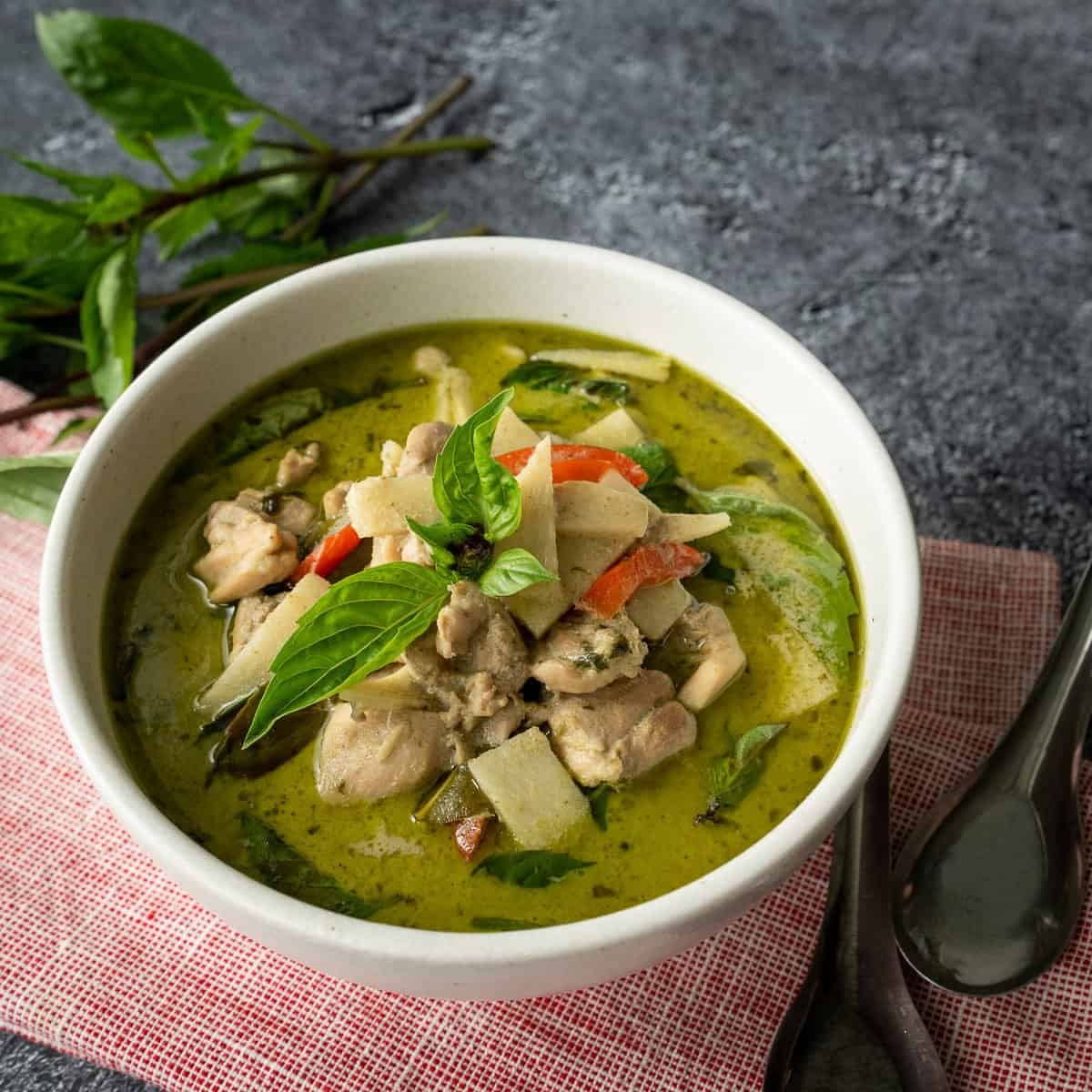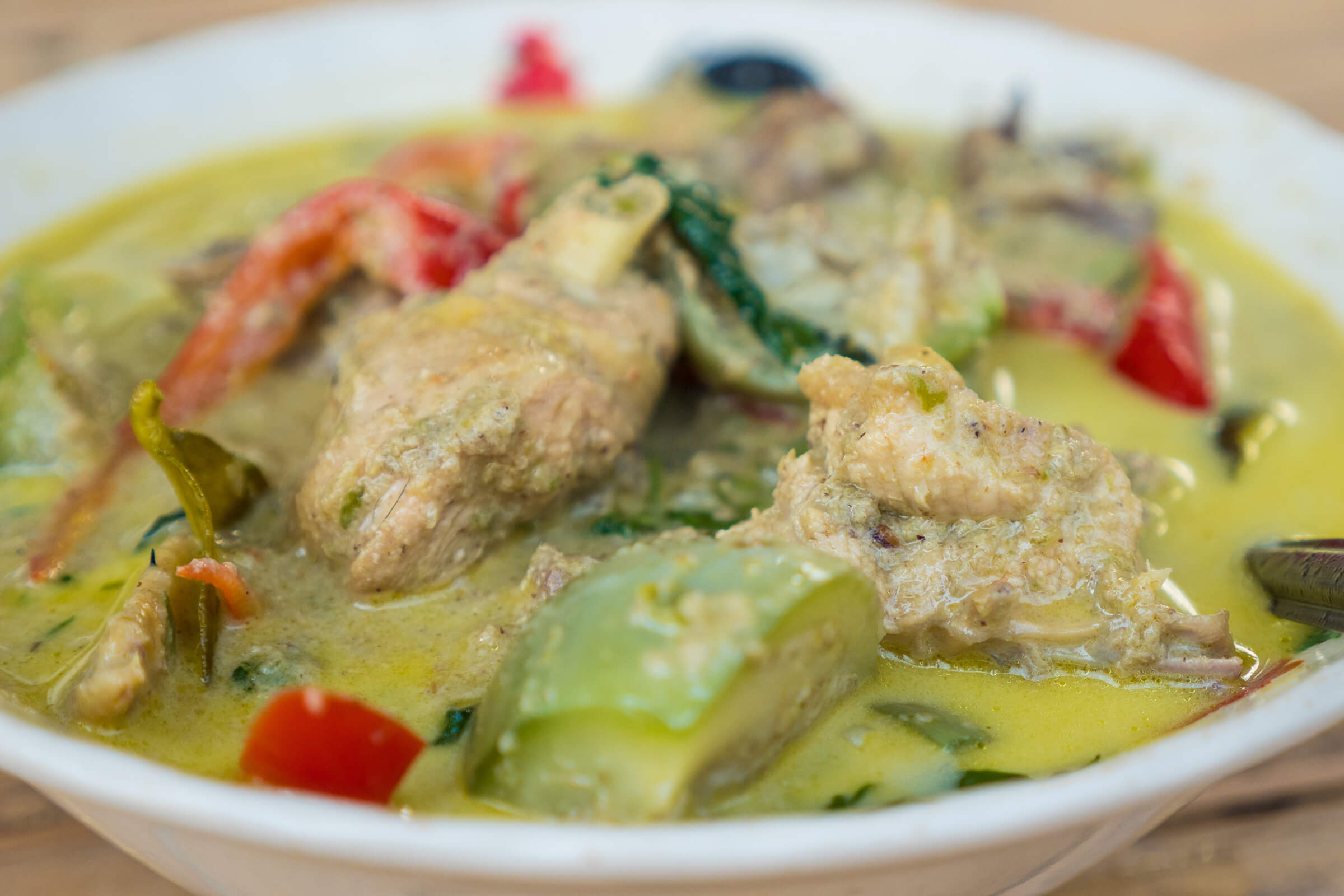Embark on a tantalizing culinary adventure as we delve into the secrets of authentic Thai green curry, a symphony of flavors that has captivated palates worldwide. From crafting the aromatic green curry paste from scratch to exploring the nuances of its ingredients and cooking techniques, this comprehensive guide will equip you with the knowledge and skills to recreate this iconic dish in your own kitchen.
Beyond its culinary delights, Thai green curry offers a glimpse into Thailand’s rich culinary heritage and its emphasis on fresh, vibrant ingredients. Join us as we unravel the complexities of this beloved dish, ensuring that every spoonful transports you to the bustling streets of Bangkok.
Authentic Thai Green Curry Paste
Creating an authentic Thai green curry paste from scratch is essential for capturing the vibrant flavors of this classic dish. This homemade paste allows for customization of heat level and flavor profile, ensuring a truly unique and delicious curry experience.
Fresh Ingredients and Traditional Techniques
Authentic Thai green curry paste relies on the freshness and quality of its ingredients. Using fresh green chilies, kaffir lime leaves, galangal, and lemongrass provides the vibrant color and aromatic flavors characteristic of this paste. Traditional techniques, such as using a mortar and pestle to grind the ingredients, enhance the release of essential oils and create a smooth, flavorful paste.
Heat Level and Flavor Profile
The heat level of the green curry paste can be adjusted by varying the amount of green chilies used. For a milder paste, use fewer chilies, and for a spicier paste, use more. Additionally, the flavor profile can be customized by adding other ingredients, such as fresh herbs like cilantro or basil, or a touch of sweetness with palm sugar or honey.
Green Curry Ingredients and Substitutions
Authentic Thai green curry is a flavorful and aromatic dish that combines the spicy heat of green chilies with the creamy richness of coconut milk. To achieve the authentic taste, it’s essential to use the right ingredients. Here’s a list of the essential ingredients and suitable substitutes if certain ingredients are unavailable:
Essential Ingredients:
- Green Curry Paste: This is the heart of the curry and provides the distinctive green color and spicy flavor. If you can’t find authentic Thai green curry paste, you can make your own using fresh green chilies, garlic, galangal, lemongrass, coriander, cumin, and kaffir lime leaves.
- Coconut Milk: Use full-fat coconut milk for a rich and creamy texture. If you don’t have coconut milk, you can substitute it with a mixture of heavy cream and water.
- Chicken or Vegetables: Chicken is the most common protein used in green curry, but you can also use tofu, shrimp, or other vegetables.
- Bamboo Shoots: These add a crunchy texture and a slightly sweet flavor to the curry.
- Kaffir Lime Leaves: These aromatic leaves provide a citrusy and floral note to the curry. If you can’t find kaffir lime leaves, you can substitute them with lime zest or lemongrass.
- Fish Sauce: This adds a salty and umami flavor to the curry. If you don’t have fish sauce, you can substitute it with soy sauce or salt.
- Palm Sugar or Brown Sugar: This adds a subtle sweetness to the curry and balances the spicy heat. If you don’t have palm sugar, you can substitute it with brown sugar or granulated sugar.
Step-by-Step Cooking s
Mastering the art of authentic Thai green curry requires a meticulous approach and an understanding of traditional techniques. This comprehensive guide will lead you through each step, ensuring a flavorful and authentic culinary experience.
The cooking process can be divided into several logical sections, each requiring specific attention to detail. From preparing the ingredients to simmering the final dish, every step contributes to the symphony of flavors that defines this beloved Thai delicacy.
Preparing the Ingredients
- Gather all necessary ingredients, ensuring the freshest produce and authentic Thai spices.
- Slice the vegetables into uniform pieces for even cooking. Green bell peppers, bamboo shoots, and Thai basil add texture and vibrant colors to the curry.
- Cut the protein of your choice into bite-sized pieces. Chicken, shrimp, or tofu are popular options.
Cooking the Curry Paste
The heart of Thai green curry lies in the aromatic curry paste. This flavorful blend is typically made from fresh green chilies, galangal, lemongrass, kaffir lime leaves, coriander, cumin, and other spices.
- Heat a heavy-bottomed pot over medium heat. Add a tablespoon of coconut oil or vegetable oil.
- Add the curry paste and sauté until fragrant, stirring constantly to prevent burning. The paste should turn a vibrant green.
Simmering the Curry
Once the curry paste is aromatic, it’s time to add the remaining ingredients and simmer the curry to perfection.
- Add coconut milk to the pot and bring to a gentle simmer. The amount of coconut milk used will determine the thickness of the curry.
- Incorporate the prepared vegetables and protein into the simmering liquid.
- Season with fish sauce, palm sugar, and lime juice to balance the flavors.
- Simmer the curry for 15-20 minutes, or until the vegetables are tender and the protein is cooked through.
- Add fresh Thai basil leaves towards the end of cooking for an aromatic finish.
Serving Suggestions and Variations

Indulge in the authentic flavors of Thai green curry, traditionally served with fluffy jasmine rice that soaks up every delicious bite. Alternatively, immerse yourself in the soft, chewy textures of roti or the sticky sweetness of glutinous rice.
Embark on a culinary adventure by customizing your green curry to suit your palate. Experiment with an array of vegetables, such as crisp bell peppers, tender baby corn, or vibrant carrots. Elevate the protein content with succulent chicken, firm tofu, or savory seafood.
Accompanying Ingredients
- Jasmine rice: A classic pairing that absorbs the flavorful curry sauce.
- Roti: A soft, flatbread that complements the curry’s richness.
- Sticky rice: Glutinous rice with a chewy texture, perfect for dipping into the curry.
Variations
- Vegetable green curry: Omit the protein and add a medley of vegetables for a vibrant and healthy dish.
- Chicken green curry: Tender chicken pieces add a savory touch to the classic recipe.
- Seafood green curry: Delight in the flavors of the sea with succulent shrimp, mussels, or calamari.
- Green curry noodles: Add cooked noodles, such as rice noodles or udon, for a satisfying and slurpable variation.
Troubleshooting Common Issues
When cooking Thai green curry, it’s not uncommon to encounter certain challenges. Here are some common issues and practical solutions to help you achieve a delicious and authentic dish:
Curry is too spicy
* Reduce the amount of green chilies used in the curry paste.
- Add more coconut milk or cream to balance the heat.
- Serve with plain rice or yogurt to help cool down the spice.
Curry is too watery
* Simmer the curry for a longer period to reduce excess liquid.
- Add a cornstarch slurry (equal parts cornstarch and water) to thicken the sauce.
- Use a thicker coconut milk, such as canned full-fat coconut milk.
Curry lacks flavor
* Ensure you’re using fresh and flavorful ingredients, especially the herbs and spices.
- Add a splash of fish sauce or soy sauce to enhance the umami flavor.
- Experiment with different types of green chilies, such as serrano or jalapeño, to add more depth of flavor.
Health Benefits and Nutritional Information

Indulge in the culinary delight of Thai green curry while reaping its remarkable health benefits. This flavorful dish boasts antioxidant and anti-inflammatory properties, promoting overall well-being.
Delve into the nutritional composition of this culinary masterpiece. Each serving provides a balanced array of calories, macronutrients, and micronutrients. The use of fresh ingredients and traditional cooking methods further enhances its nutritional value, making it a wholesome choice.
Antioxidant and Anti-inflammatory Properties
- Thai green curry is a rich source of antioxidants, such as flavonoids and carotenoids. These compounds combat free radicals, protecting cells from damage and reducing the risk of chronic diseases.
- The presence of turmeric, a key ingredient in green curry paste, contributes to its anti-inflammatory properties. Curcumin, an active compound in turmeric, has been shown to alleviate inflammation throughout the body.
Nutritional Breakdown
| Nutrient | Amount per Serving |
|---|---|
| Calories | ~250 |
| Carbohydrates | ~30g |
| Protein | ~15g |
| Fat | ~10g |
| Fiber | ~5g |
| Vitamin C | ~10% Daily Value |
| Vitamin A | ~5% Daily Value |
| Iron | ~10% Daily Value |
Final Summary
As you master the art of crafting authentic Thai green curry, you not only gain culinary prowess but also embark on a journey of cultural discovery. Each ingredient, each technique, and each variation holds a story, connecting you to the vibrant tapestry of Thai cuisine.
May this guide serve as your trusted companion, empowering you to recreate this culinary masterpiece and share the joy of authentic Thai flavors with those you love.
Answers to Common Questions
Q: What is the secret to achieving the perfect balance of flavors in Thai green curry?
A: The key lies in the harmonious interplay of spicy, sweet, salty, and sour notes. Adjust the proportions of green chilies, coconut milk, fish sauce, and lime juice to find your ideal balance.
Q: Can I substitute green chilies with another type of chili pepper?
A: While green chilies impart the authentic flavor, you can use serrano or jalapeño peppers as substitutes. However, adjust the quantity as they tend to be hotter.
Q: How do I store leftover Thai green curry?
A: Allow the curry to cool completely, then transfer it to an airtight container and refrigerate for up to 3 days. Reheat gently over medium heat, stirring occasionally.
